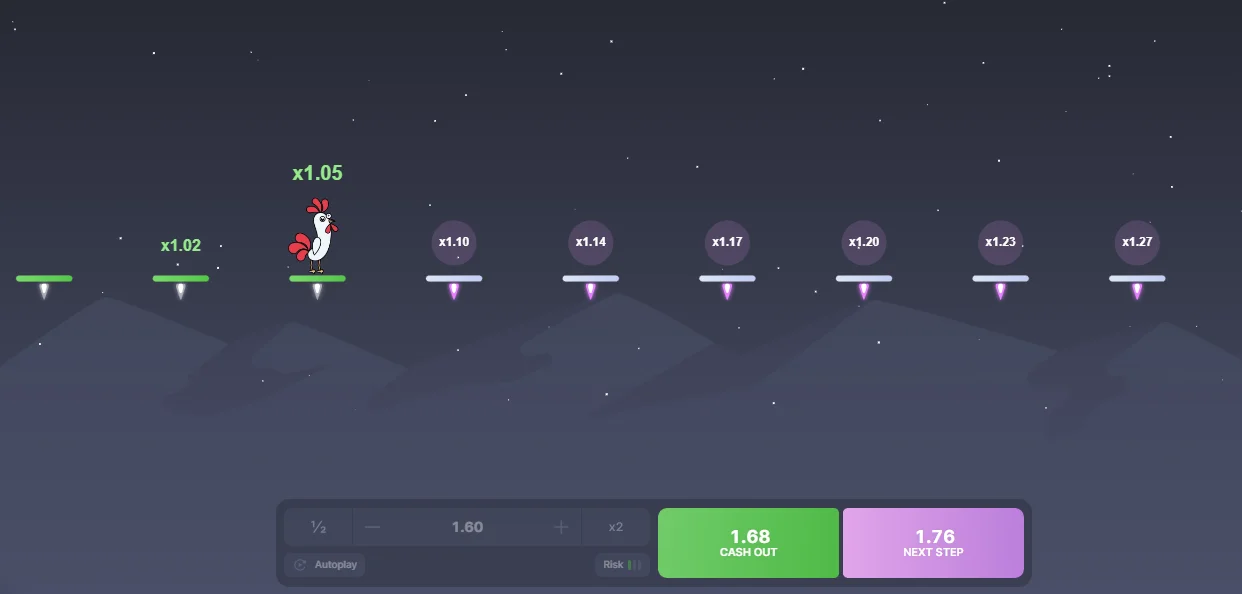Rooster Run Game
Rooster Run is a fast-paced crash game from Mascot Gaming where a runaway rooster leaps from one platform to the next. Each jump raises the potential payout, but one wrong step and the round ends. The Rooster Run demo is a great way to get familiar before risking real money.
Game Info
| 🔧 Provider: Mascot Gaming | 🔥 Volatility: High | 📱 Mobile Compatible: Yes |
| 📅 Release: 2025 | 🎯 RTP: 95% | 📲 Mobile Optimized: Yes |
| 💰 Max Win: x10,000 | 💶 Min Bet: $0.01 | 🧪 Provably Fair: No |
| 🎯 Win Range: Increases per step | ➕ Multiplier Range: 1x – 10,000x | ➗ Multiple Bets: Yes |
| 🎮 Game Type: Crash / Instant Game | ⏱ Betting Time: Seconds per round | 💬 Chat Room: No |
| 🎨 Theme: Farmyard, Platform Run, Cartoon | ⌛ Game Duration: Variable | 🎁 Free Bets: No |
| 🧮 House Edge: ~5% | 🤖 Auto Bet: Yes | 🏆 Leaderboard: Yes |
Rooster Run is a crash-style gambling game built around fast rounds, growing multipliers, and sharp decisions. It stands out thanks to its playful design, mobile support, and high volatility combined with a 10,000x max win. For anyone trying crash games or exploring Mascot Gaming titles, this one is worth a close look.

Best Casinos to Play Rooster Run
If you’re looking to try the Rooster Run game for real money, I recommend starting with a reliable casino. Below, I’ve added one that I personally tested and found safe, stable, and fully compatible with both the Rooster Run demo and full game.
When choosing where to play, make sure the casino is licensed, supports Mascot Gaming games, and offers fair terms. It should also provide fast payouts, secure deposits, and a clear way to access the demo without jumping through hoops.
About Rooster Run
Rooster Run by Mascot Gaming puts a new spin on the crash game format. Instead of reels or cards, you’re guiding a rooster that jumps across floating platforms. With each jump, the multiplier grows — but one wrong move, and it’s game over. The Rooster Run demo game gives you a real sense of that tension. Here’s what makes it stand out:
- 🐓 Three selectable risk levels (Low / Medium / High): Each mode changes the number of jumps and the size of the final multiplier. Higher risk means fewer platforms but much bigger potential wins — up to x10,000.
- 🔁 Step-by-step jumping: The rooster jumps one platform at a time. After each step, you decide whether to take the win or try for the next.
- ▶️ Two autoplay modes: One option lets the rooster jump forward automatically, one step at a time. The other goes straight for a target multiplier — and either lands it or crashes.
- 🎮 Ranked progression and customisation: As you play, you unlock avatars and themes. It’s a small detail, but it adds a sense of progression and personalisation.
- 📊 Live leaderboard: The top players and biggest multipliers are shown in real time. It brings in a touch of friendly competition, even in a solo game.
Rooster Run does a solid job combining quick decisions with clean design. There’s no clutter — just you, the rooster, and the next platform ahead.
Game Mechanics Rooster Run
Rooster Run is built around a simple but sharp idea: you place a bet, and a cartoon rooster starts jumping from one platform to the next. Each jump raises the multiplier. You can collect your winnings at any moment — but if the next platform breaks, you lose the round. It’s all about knowing when to stop.
The controls are clean and responsive. One tap places your bet, another locks in your win. The game doesn’t keep you waiting — each round starts instantly, and you decide the pace.
Visually, Rooster Run keeps things light. The floating platforms and running rooster are drawn in a colourful cartoon style. Animations are smooth, and the design stays focused on the action. There’s no background clutter, just the rooster, the path, and the growing tension.
Sound effects are used sparingly. You’ll hear a soft jump noise, light background music, and a sharp cue if the rooster falls. It’s enough to keep things engaging without getting in the way.
Rooster Run runs smoothly on desktop, tablet, and mobile browsers. No downloads are needed — the game launches instantly in HTML5, whether you’re playing the demo or real money version.
RTP, Multipliers and Paytable
Understanding the numbers behind a crash game helps make smarter choices. Rooster Run follows a high-volatility model with rising multipliers and a clearly defined structure. Below is a quick breakdown based on real testing in the Rooster Run demo and full game:
| Game Statistic | Value |
|---|---|
| RTP | 95% |
| Volatility | High |
| Max Win | 10,000× your bet |
| Multiplier Growth | Exponential per jump |
The paytable in Rooster Run isn’t based on symbols or paylines — it’s built entirely around multiplier steps. Each jump moves the rooster forward and increases the payout if you cash out in time. Here’s what you can expect at each risk level:
- 🟢 Low Risk (30 jumps): Max payout around 21.49×. Multipliers grow slowly, round lasts longer, lower crash chance.
- 🟠 Medium Risk (25 jumps): Max payout up to 2,287.23×. Faster multiplier growth, balanced danger.
- 🔴 High Risk (21 jumps): Max payout is the full 10,000×. Multipliers grow fast — and so does the chance of crashing early.
There are no symbols, no paylines, and no randomness in the visual layout — the randomness is in when the crash hits. That simplicity is what gives Rooster Run its bite. Once you understand the payout structure, you know what’s at stake every time you click “Cash Out”.
How to Play Rooster Run
Rooster Run is easy to learn, even if it’s your first time trying a crash-style game. Here’s how a typical round works — step by step:
- Set your bet: Choose how much you want to wager. The minimum is low, so you can start small if you’re just testing things out.
- Select a risk level: Pick between Low, Medium, or High. This changes the number of platforms and the size of the maximum multiplier.
- Start the round: Press the bet button — the rooster jumps onto the first platform, and the multiplier begins.
- Watch the jumps: The rooster continues hopping across platforms, one by one. Each successful jump increases your potential payout.
- Cash out or keep going: At any point, you can click “Cash Out” to collect your current multiplier. If you wait too long and the platform breaks, you lose the round.
- Repeat or adjust: After the round ends, you can place a new bet, switch risk modes, or activate autoplay with your preferred settings.
There’s no waiting for timers or reels — each round is instant and fully in your control. That’s what makes Rooster Run different from most traditional casino games.

Rooster Run Game Features and Bonuses
Rooster Run may look simple at first glance, but once you’ve played a few rounds, the smart mechanics start to show. Below are three gameplay features that stand out — they’re not just extras, they define how the Rooster Run game works round after round.
🎯 Selectable Risk Levels That Affect the Whole Structure
Each round starts with a choice: Low, Medium or High risk. This isn’t just a label — it changes everything. The number of platforms, the size of each multiplier step, and the crash frequency are all tied to your choice. In Low risk, you’ll face more steps with safer jumps. In High risk, you get fewer steps but bigger leaps in value. I found myself switching risk levels depending on how lucky I felt — and how long I wanted to stay in a session.
⚙️ Two Autoplay Modes With Manual Control
Rooster Run includes two distinct autoplay systems. One lets the rooster move forward one platform at a time, still giving you the option to cash out manually. The second lets you define a target multiplier — the rooster jumps straight toward it, and either hits it or crashes. It’s not just convenience — it changes how you approach each round. I used step-by-step autoplay to stick to a pattern, then switched to full-speed mode when I wanted to test higher risks without second guessing.
🧩 Progression System and Visual Rewards
This isn’t a slot machine with nothing beyond payouts. As you play, you level up in the background and unlock new interface themes and avatars. These changes don’t affect your odds, but they add a subtle reward for staying with the game. You can also see your current progress and track your place in the leaderboard. It’s a simple system, but it gives the Rooster Run demo and real mode an extra layer of motivation — especially when you’re close to unlocking the next rank.
Pros and Cons of Rooster Run
Rooster Run isn’t trying to do too much — and that’s one of its strengths. It focuses on fast, risk-based rounds and gives you enough tools to shape your own session. But like any crash game, it has limits depending on what kind of player you are.
✅ Pros:
- Three clearly defined risk levels with meaningful differences
- Max win of 10,000× gives room for bold plays
- Autoplay and manual control modes offer real flexibility
- The progression system adds a reason to return beyond money
- No waiting between rounds — gameplay is fast and constant
- Clean interface with no distractions or clutter
- Rooster Run demo available without login
❌ Cons:
- No traditional bonus rounds or free spin features
- Visuals are simple — not much variety after a while
- Sound design is minimal and may feel repetitive
- High-risk mode can lead to fast bankroll swings
- No provably fair mechanic or public crash algorithm
Rooster Run does what it sets out to do — it’s a straightforward, strategic crash game with strong foundations. If you’re after big animations or layered bonuses, it won’t be your thing. But if you like clean mechanics, quick decisions, and clear risk–reward, it delivers exactly that.
Rooster Run: Demo Mode
Before placing real bets, it’s a smart move to test the Rooster Run demo. It’s the same game, same risk levels, and same mechanics — but played with virtual credits. There’s no registration needed on most platforms, and you can try every feature without spending a penny.
The Rooster Run demo game lets you figure out how fast the multipliers grow, when crashes happen, and how each risk level behaves. You can try different autoplay setups or just get used to the rhythm of jumps. I found it especially useful for learning the pace of medium and high risk modes — those rounds move fast, and the demo helped me avoid early mistakes.

There is a fully working, browser-based demo version of Rooster Run. No download, no signup, no pressure — just play, adjust, and see what works before betting real money.

Rooster Run: Mobile App and APK
Rooster Run was built with mobile players in mind. The game runs smoothly in any modern browser — no need to install a separate app or download an APK file. Just open the casino site on your phone or tablet, launch the game, and everything loads automatically.
The interface adapts well to smaller screens. Buttons stay easy to tap, the multiplier path scrolls horizontally if needed, and performance stays smooth even on older devices. I tested Rooster Run on Android and iPhone, and it worked just as well as on desktop.
If your casino offers a dedicated app, you might find Rooster Run inside it. But even if not, the mobile version through the browser works perfectly. That means no storage space wasted, no updates to manage — and instant access whenever you want to jump in.
Tips for Successful Play
Rooster Run looks simple — and it is. But after enough rounds, patterns start to show. These tips are based on what actually made a difference in my sessions. Not theories — just things that helped me stay in control and get more from the game.
- Use Medium risk as a testing ground.
It’s the only mode that gives a real balance between safety and high potential. I found that Medium risk helped me learn the timing of cash-outs, since jumps matter more than in Low but don’t punish you as hard as High. - Change risk level mid-session.
Don’t play the same mode round after round. If you’re on a cold streak in High risk, drop down to Low for a few calmer bets. If Low gets too slow, switch to Medium. Changing rhythm can reset your mindset and help avoid tilt. - Set soft cash-out targets — but allow instinct.
I used to stick to fixed multipliers (like 2× or 5×), but that got too predictable. Now I use ranges. For example, if I plan to exit around 3×, I watch from 2.5× to 4× and decide based on how the run “feels”. It adds flexibility without chaos. - Avoid jumping in right after a big crash.
Rooster Run isn’t truly predictable, but in my play I noticed early crashes sometimes come in clusters. If a round ends instantly, I often wait one or two before placing my next bet — especially in High risk. - Watch the leaderboard for clues, not pressure.
The live leaderboard can hint at recent win patterns or active sessions. I don’t chase the top spot, but if I see many low multipliers winning, I consider adjusting risk or pausing.
Rooster Run rewards players who stay alert, adapt, and know when to back off. It’s not about chasing the 10,000× — it’s about staying sharp for that one moment where the timing is just right.

Why You Should Try Rooster Run
Rooster Run offers something different from most crash games — and that alone makes it worth trying. The mix of risk levels, clean design, and instant rounds gives it a pace that works whether you’re in for a quick session or something longer. It doesn’t try to overwhelm you with effects or mini-games — the core idea stays clear and focused.
What I liked most is how much control the game gives you. You decide the risk, the timing, and the cash-out point. And with autoplay options and a working demo, it’s easy to test strategies before playing with real money.
It won’t appeal to everyone — especially if you’re after complicated features or flashy graphics. But if you enjoy games where every click matters, Rooster Run delivers that tension in a simple and direct way. I’ve played a lot of crash titles, and this one earns a place among the better ones. Try it for yourself — and see how far your rooster gets.

John Ashton
John Ashton is a passionate game reviewer with a keen eye for innovative mechanics and emerging trends in the gaming world. With years of experience exploring everything from indie experiments to mainstream hits, he focuses on breaking down gameplay in a way that’s clear, honest, and engaging. His reviews are known for balancing technical insight with a player’s perspective — making him a trusted voice among casual gamers and enthusiasts alike.


